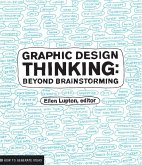The Bauhaus, the legendary school in Dessau, Germany, transformed architecture and design around the world. This book broke new ground when first published in 1991 by introducing psychoanalysis, geometry, early childhood education, and popular culture into the standard political history of the Bauhaus.
The ABC's of Triangle, Square, Circle also introduced two young designers, Ellen Lupton and J. Abbott Miller, whose multidisciplinary approach changed the field of design writing and research. With a new preface by Lupton and Miller, this collection of visually and intellectually stimulating essays is a must-read for educators and students.
The ABC's of Triangle, Square, Circle also introduced two young designers, Ellen Lupton and J. Abbott Miller, whose multidisciplinary approach changed the field of design writing and research. With a new preface by Lupton and Miller, this collection of visually and intellectually stimulating essays is a must-read for educators and students.
"The book disquiets the mythology surrounding the Bauhaus by dissecting the conflicting principles of design, form and visual perception. [...] Whilst challenging the ambitions of the movement, the monograph presents design criticism through precisely assembled diagrams and layouts in a manner that recognises the Bauhaus' pedagogical and theoretically self-conscious ideals." Aesthetica








